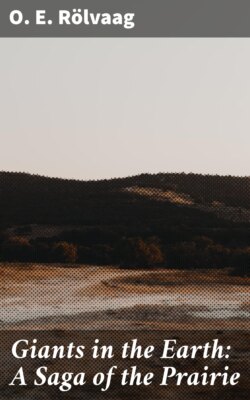Читать книгу Giants in the Earth: A Saga of the Prairie - O. E. Rölvaag - Страница 8
На сайте Литреса книга снята с продажи.
V
ОглавлениеTable of Contents
Does Rölvaag's work belong legitimately to Norwegian or to American literature? The problem has unusual and interesting features. The volume before us deals with American life, and with one of the most characteristically American episodes in our history. It opens on the western plains; its material is altogether American. Yet it was written in Norwegian, and gained its first recognition in Norway. Whatever we may decide, it has already become a part of Norwegian literature. Rölvaag's art seems mainly European; Rölvaag himself, as I have said, is typically American. His life and future are bound up in the New World; yet he will continue to write in a foreign language. Had he been born in America, would his art have been the same? It seems unlikely. On the other hand, had he remained in Norway--had he accepted the boat that fine, clear day in Nordland--how would his art have fared?
But such speculation, after all, is merely idle; these things do not matter. It has not yet been determined, even, what America is, or whether she herself is strictly American. And any sincere art is international. Given the artist, our chief interest lies in trying to fathom the sources of his art, and to recognize its sustaining impulses. What were the forces which have now projected into American letters a realist of the first quality writing in a foreign language a new tale of the founding of America? It is obvious that these forces must have been highly complex and that they will continue to be so throughout his working life; but beyond that we cannot safely go. The rest is a matter of opinion. When I have asked Rölvaag the simple question, Did Norway or America teach you to write? he has invariably thrown up his hands.
The same speculation, in different measure, applies to a considerable quantity of Norwegian-American literary production which as yet our criticism knows nothing about. The Norwegians are a book-loving people; no set of adverse conditions can for long restrain them from expressing themselves in literary form. Here in the Northwest, during the last thirty or forty years, they have built up a distinctive literature, written and published in the Norwegian language, but concerned wholly with American life. Until quite recently, in fact, the region supported a Norwegian fiction magazine.
There are the five substantial novels of Simon Johnson, for instance, with many short stories by the same author. There are the romantic novels of H. A. Foss; and the poetry, short stories, novels, and travelogues of Peer Strömme. There are the polemical and poetical works of O. A. Buslett, obscure and fantastic. There are the three novels and four collections of short stories by the able writer, Waldemar Ager. There is the lyric poetry of Julius B. Baumann and O. S. Sneve, the collected works of both of whom have now been brought out. There are the amazing Biblical dramas of the farmer-poet Jon Norstog--huge tomes with the titles of Moses, and Israel, and Saul, set up by his own hand and published from his own printing press, in a shanty on the prairies of North Dakota--works that reveal the flash of genius now and then, as I am told. Do all these serious efforts belong to Norwegian or to American literature? Their day is nearly done; the present generation of Norse stock has another native language. But it would be of value to have some of this early Norwegian-American product translated into English, to enrich our literature by a pure stream flowing out of the American environment--a stream which, for the general public, lies frozen in the ice of a foreign tongue.
LINCOLN COLCORD
Minneapolis, Minnesota, January, 1927
